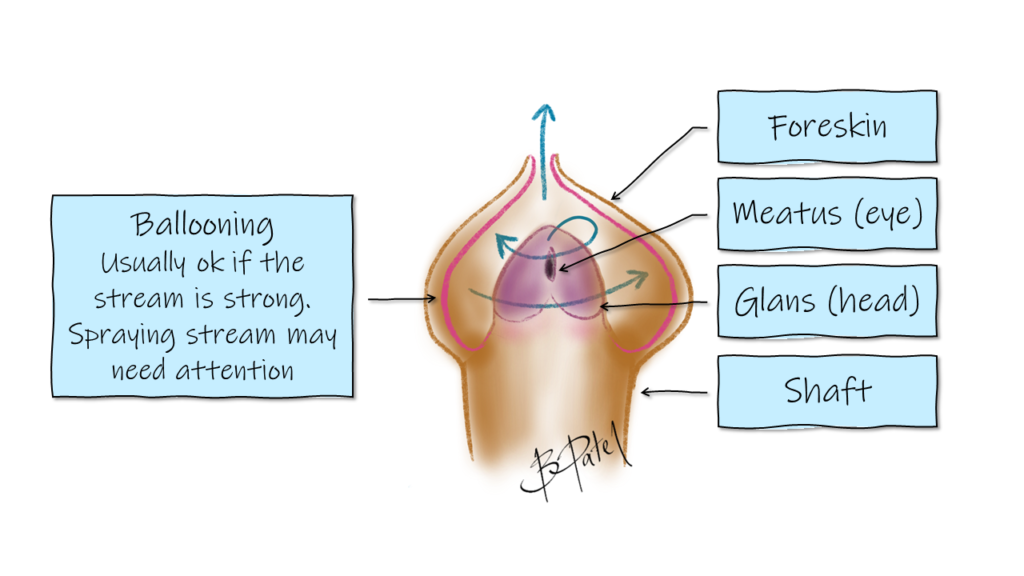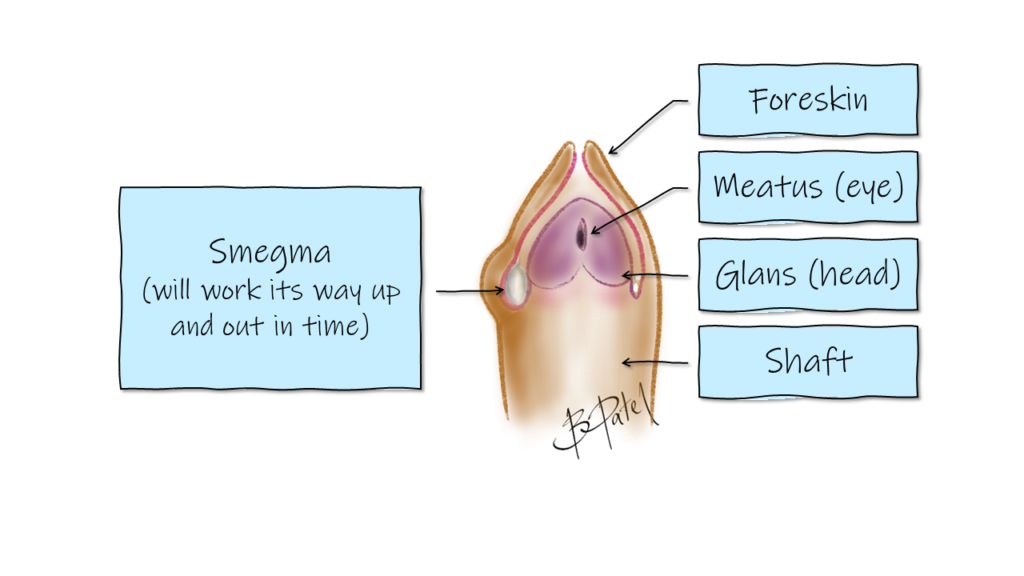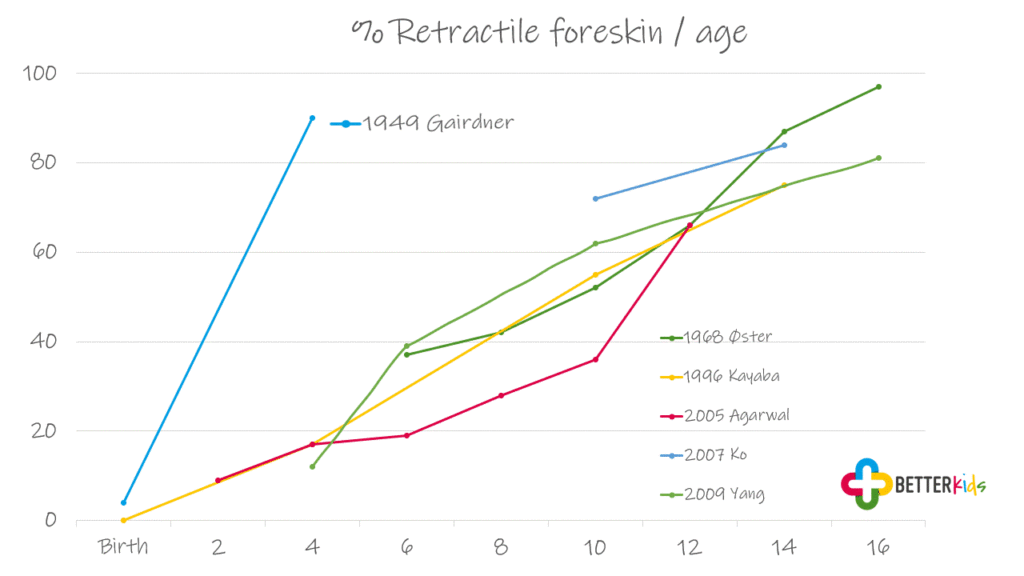Circumcision
There are many reasons for circumcision in boys. In Australia about 1 in 5 boys are circumcised for various reasons. We perform circumcision as a surgical procedure under general anaesthetic.
The Normal and Abnormal Foreskin
When should the foreskin retract?
The median age of full foreskin retraction is around 10 years age. This means 50% of boys can pull the skin back before, and the other half after the age of 10 years. If the foreskin is only partially developed, the glans (head) may be visible. This can be a condition called hypospadias, where there is a deficiency of development of the ventral (undersurface) of the penis.
There is no need to pull the foreskin back until it naturally does so. In fact, forcing the foreskin to retract too early can result in scarring and problems in the future.
Hygiene is done simply in a bath or shower. In the younger age group, a bath is better to allow the water to soak the area more effectively.
As you can see in the graph, Gairdner’s opinion was not based on scientific research, like the other research that was done afterwards. Almost all boys can retract the foreskin at the time of puberty. This age varies between boys, and is usually between 12-16 years.
Ballooning
There are different types of “ballooning” while urinating.
Most boys develop a bulge of the shaft, and the stream is normal. The urinary stream can initially be diverted, however straightens as the stream gets stronger.
Ballooning that is persistent, causing urine trapping after voiding is a problem. Often the urinary stream is very poor. There is dribbling, spraying and in worse cases the urine needs to be manually “milked” out.
Urine trapping can result in foreskin irritation from chemical dermatitis. To avoid this, use a tissue paper to “wick” the urine from the tip of the foreskin.

Partial retraction
The median age for full foreskin retraction is 10 years. This means 50% of boys can pull the skin back before, and the other half after the age of 10 years.
The layers between the glans penis (head of the penis) and the inner prepuce (inner layer of the foreskin) separate over a long time. It happens slowly, and one side may retract earlier, so you might notice it is partially retractile on the other side. This is all normal.
What is that white cheesy material?
It is called smegma.
This is keratin production / skin cells between the layers of skin of the glans (head) and the inner layer of the foreskin. This is how the foreskin will eventually become retractile. The little smegma pearls work their way up and out, which separates the layers. It happens slowly, and one side may retract earlier, so you might notice it is partially retractile. This is all normal.

How do I clean it?
Hygiene is done simply in a bath or shower. In the younger age group, a bath is better to allow the water to soak the area more effectively.
A bath will allow the water to rinse the area well. Showers are ok, however sometimes do not allow the foreskin to soak long enough. The foreskin can be soaked in a cup of warm water while in the shower.
The foreskin does not need to be retracted for cleaning, unless it naturally already does so.
Balanitis
Infection of the penis and foreskin is called balanitis. The term balanoposthitis is used when the entire shaft is infected. There is swelling, redness, pain and tenderness of the foreskin. With real balanitis, there is purulent discharge (pus) as well.
Balanitis is often treated with baths, topical ointment and / or oral antibiotics. It usually settles after a few days. Recurrent episodes of infection may be a reason to consider circumcision.
Urinary tract infection
There are a few conditions of the renal tract (kidneys, ureters and bladder) that pose a higher risk for developing urinary tract infections. One of the main conditions is called vesico-ureteric reflux.
Circumcision may result in a lower risk of infection in these conditions.
Phimosis
A condition where the foreskin does not retract. There are a few reasons for this to occur:
– Its normal (physiological) in the younger age group. The median age for full foreskin retraction is 10 years. Forcing the foreskin to retract too early could result in scarring and problems in the future.
– Its abnormal (pathological). This is associated with scarring, often in the 7-10 year old boys, who develop a condition called BXO (balanitis xerotica obliterans). Treatment with circumcision is often the only way to treat this condition.

Circumcision / Treatment
Should I have my newborn boy circumcised?
There is not enough reason for routine circumcision in all newborn boys. This comes from worldwide consensus from organisations such as the Royal Australasian College of Physicians, American Academy of Pediatrics and the Canadian Pediatric Society.
Currently 1 in 5 boys in Australia is circumcised.
We are happy to discuss circumcision with you.
Circumcision
The operation takes about 15-20 minutes, and is performed under general anaesthetic as a day procedure. We place local anaesthetic to also numb the area, which lasts for a few hours.
The foreskin is marked, and surgically removed. Dissolvable sutures are used to seal the wound, and a simple dressing placed around the shaft.
The anaesthetic can take about the same time before and after, so you’ll be away from your child for an hour or so, until they are ready for you the recovery room. You will be notified when they are ready for you to see them in recovery.
We will discuss the procedure with you shortly after the procedure, and go through aftercare.
Are there other options?
Your surgeon will speak to you about options.
Steroid cream – this can be effective in certain situations, where a circumcision is not necessary
Partial circumcision / preputioplasty – this is an option if preservation of the foreskin is a priority for you.
Time – sometimes no treatment is needed at all! Pubertal development and growth will allow some of the issues to resolve, so waiting more time in some cases is worthwhile.
What are the risks of the operation?
Circumcision in Australia is fairly safe when performed by a qualified experienced medical practitioner. Common risks occur in about 2-10%.
- Bruising and swelling – can be a little scary to see initially. This lasts about a week.
- Infection – not common with appropriate hygiene and post-operative care
- Bleeding – uncommon. Usually this settles with gentle pressure, however rarely may need a visit to the emergency department.
- Long term risks include narrowing of the meatus (the hole that urine exits through) – called meatal stenosis
- Anaesthetic risks will be discussed by the anaesthetist.
Recovery / Aftercare
What happens after the operation?
Recovery – you will be called into the recovery room just after they are awake.
Feeding – you can give your child a feed in the recovery room.
Home – usually after an hour or 2, once the nursing team have ensured your child is safe and comfortable, and we ensure passing urine is easy.
The wound / Dressings
The area will become swollen and bruised. This is a normal healing process in the first week or so.
There is a waterproof silicone dressing around the shaft, and occasionally a more firm white wrap dressing in the older boys. The dressing will fall off after 1-2 days.
You will be provided with liquid paraffin and white paraffin for topical application as the area becomes itchy for the first week.
Apply 2-3 drops of liquid paraffin topically every few hours for a few days, then white paraffin for a week or so.
Pain relief
Your child will receive good local anaesthetic pain relief in the operating room, that will make the penis numb for a few hours.
After the operation they will need paracetamol and possibly ibuprofen (eg. Nurofen) for a few days. Please let your surgeon and anaesthetist know if your child has intolerances or allergies.
You will also be provided with liquid paraffin and white paraffin for topical application as the area becomes itchy for the first week.
In order to avoid medication, aim to distract your child and keep their mind off the area. Reading, writing, playing board games and other engaging activities help.
Normal activity
Bath / shower – the day after the operation
Swimming – 1 week
Daycare / School – 5-7 days
Sports – 2-3 weeks
Troubleshooting
Bleeding
It is common for a little ooze to develop from the swelling. Sometimes there is itchiness and your boy may inadvertently try to “scratch” the area. See “Itchiness” below.
If there is visible dripping of blood, use gentle pressure with a paper towel or similar, for 5 minutes.
If there is still bleeding, keep it wrapped under gentle pressure and take your boy to the nearest emergency department. Do not give anything to eat or drink if you are going to the emergency department. He can have pain relief prior to attending.
Is there an infection?
Infections can develop around 2-4 days after the operation, and is a fairly uncommon issue. Often there is a dry crust that forms. This is not infection.
The wound may be infected if there is increasing redness around the wound and tenderness. This may be associated with discharge from the wound site.
You will need to see your family doctor or call your surgeon for further advice.
It is very swollen
It does become swollen after the operation, usually for a few days. It can double in size and look quite alarming.
If you are concerned, please call your surgeon so your child can be assessed.
Itchiness
This is a common problem after circumcision. The glans (head of the penis) is now exposed to the outside, where previously it was contained within the foreskin. This makes it dry, and it can become itchy. Also any wound that is in a healing phase also becomes itchy.
We provide liquid paraffin and white soft paraffin to apply topically in the first week or so. Liquid paraffin (2-3 drops every few hours) is used for the first few days until it is less painful to apply the white paraffin directly. This can be applied for a week or so.
What do I look for?
You know your child best. If you have any concerns please see your family doctor or call your surgeon. The list below are issues that require medical attention.
- Increasing pain or persisting pain despite pain relief
- Increasing swelling or bulge
- Fever >38.2 degrees Celsius
- Vomiting and feed intolerance
- Discharge or bleeding from the wound
Experienced Surgeons
Over 25 years experience in paediatric surgery
Locations
Queensland and northern New South Wales
Appointments
Prioritised time for your child
Information
Conditions, procedures and aftercare
In the spirit of reconciliation we acknowledge the Traditional Custodians of country throughout Australia and their connections to land, sea and community. We pay our respect to their Elders past and present and extend that respect to all Aboriginal and Torres Strait Islander peoples.


